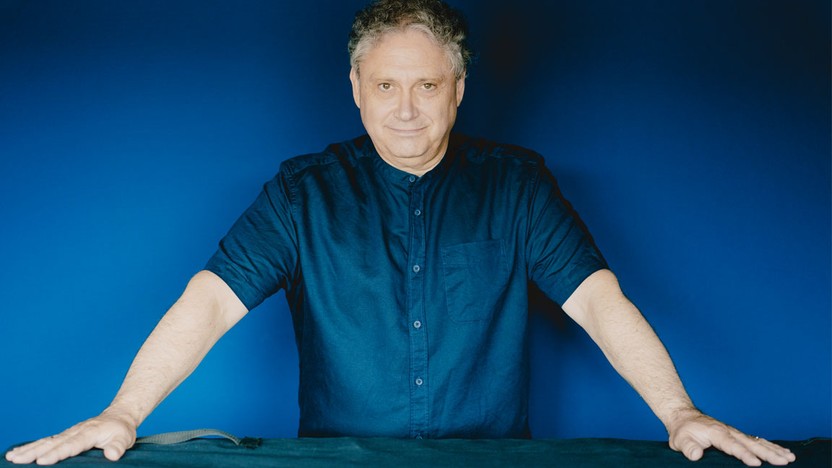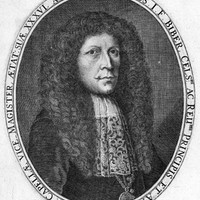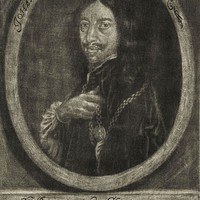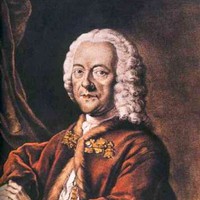Bach’s Orchestral Suite No. 3 with Richard Egarr



Well before Italians like Arcangelo Corelli and Antonio Vivaldi sparked the violin revolution that brought the Baroque style to its glorious peak after 1700, the Bohemian composer and violinist Heinrich von Biber was developing some of the most exciting and forward-thinking scores ever created from his home base of Salzburg. Even a form as prosaic as mealtime background music brought out Biber’s sense of sonic invention, as heard in the third part of Mensa sonora (“Harmonious Table”), a collection of chamber music dedicated to the Archbishop of Salzburg and published locally in 1680. The opening Gagliarda — the Italian name for the fast French court dance known as the Galliard — makes a game of breaking up the arpeggio of the main theme and bouncing it between instruments. Later, in the Ciacona, rising scale fragments echo between voices as the continuous variations intensify over a cycling bass line.
Biber had a particular knack for the art of musical scene-painting that later obsessed the Romantic composers. One early Serenade in five parts (two violins, two violins and a shared basso continuo line) manifested the nocturnal atmosphere in the most literal way, by incorporating a simple tune sung by a nightwatchman who exhorts the local folk to be on guard as the hour reaches nine and then ten. The accompanying strings play pizzicato throughout, and they return to plucking for echoing passages in the following Gavotte, preserving the atmosphere of eerie quiet.
Biber’s signature composition is his rousing Battalia (Battle) from 1673, scored for nine string instruments and basso continuo. The brief musical vignettes cover everything from the pre-battle bedlam of drunken soldiers singing overlapping songs in clashing keys and tempos to the post-battle “Lament of the Wounded Musketeers.” In between, extended techniques help to simulate military sounds. During a march, for instance, paper placed beneath the strings of a bass makes it sound more like a snare drum accompanying a fife; within the battle itself, the two basses (arranged on opposite sides) use the technique of snap pizzicato to replicate musket fire.
Aaron Grad ©2022

Johann Heinrich Schmelzer, the son of a baker from a small Austrian village, showed enough musical talent that as a teenager he was already playing violin in the Viennese court of Ferdinand III, the Holy Roman Emperor. Continuing in the service of Ferdinand’s successor, Leopold I, Schmelzer rose to become the first native Austrian to serve as Kapellmeister after a long line of Italians, a position he reached only months before he succumbed to the Plague during an epidemic that had sent the Habsburg court to Prague in a failed bid to escape the pathogen.
Schmelzer probably composed this Lament not long after the death of Ferdinand III in 1657. In the tradition of Baroque laments, pungent dissonances and descending motives serve as musical markers of weeping. There also appears to be a subtle nod to the Emperor, who was himself a composer; the Austrian conductor Lorenz Duftschmid spotted a resemble between the harmonies of this Lament and a death-themed motet composed by Ferdinand.
Aaron Grad ©2022

Well before Italians like Arcangelo Corelli and Antonio Vivaldi sparked the violin revolution that brought the Baroque style to its glorious peak after 1700, the Bohemian composer and violinist Heinrich von Biber was developing some of the most exciting and forward-thinking scores ever created from his home base of Salzburg. Even a form as prosaic as mealtime background music brought out Biber’s sense of sonic invention, as heard in the third part of Mensa sonora (“Harmonious Table”), a collection of chamber music dedicated to the Archbishop of Salzburg and published locally in 1680. The opening Gagliarda — the Italian name for the fast French court dance known as the Galliard — makes a game of breaking up the arpeggio of the main theme and bouncing it between instruments. Later, in the Ciacona, rising scale fragments echo between voices as the continuous variations intensify over a cycling bass line.
Biber had a particular knack for the art of musical scene-painting that later obsessed the Romantic composers. One early Serenade in five parts (two violins, two violins and a shared basso continuo line) manifested the nocturnal atmosphere in the most literal way, by incorporating a simple tune sung by a nightwatchman who exhorts the local folk to be on guard as the hour reaches nine and then ten. The accompanying strings play pizzicato throughout, and they return to plucking for echoing passages in the following Gavotte, preserving the atmosphere of eerie quiet.
Biber’s signature composition is his rousing Battalia (Battle) from 1673, scored for nine string instruments and basso continuo. The brief musical vignettes cover everything from the pre-battle bedlam of drunken soldiers singing overlapping songs in clashing keys and tempos to the post-battle “Lament of the Wounded Musketeers.” In between, extended techniques help to simulate military sounds. During a march, for instance, paper placed beneath the strings of a bass makes it sound more like a snare drum accompanying a fife; within the battle itself, the two basses (arranged on opposite sides) use the technique of snap pizzicato to replicate musket fire.
Aaron Grad ©2022

Well before Italians like Arcangelo Corelli and Antonio Vivaldi sparked the violin revolution that brought the Baroque style to its glorious peak after 1700, the Bohemian composer and violinist Heinrich von Biber was developing some of the most exciting and forward-thinking scores ever created from his home base of Salzburg. Even a form as prosaic as mealtime background music brought out Biber’s sense of sonic invention, as heard in the third part of Mensa sonora (“Harmonious Table”), a collection of chamber music dedicated to the Archbishop of Salzburg and published locally in 1680. The opening Gagliarda — the Italian name for the fast French court dance known as the Galliard — makes a game of breaking up the arpeggio of the main theme and bouncing it between instruments. Later, in the Ciacona, rising scale fragments echo between voices as the continuous variations intensify over a cycling bass line.
Biber had a particular knack for the art of musical scene-painting that later obsessed the Romantic composers. One early Serenade in five parts (two violins, two violins and a shared basso continuo line) manifested the nocturnal atmosphere in the most literal way, by incorporating a simple tune sung by a nightwatchman who exhorts the local folk to be on guard as the hour reaches nine and then ten. The accompanying strings play pizzicato throughout, and they return to plucking for echoing passages in the following Gavotte, preserving the atmosphere of eerie quiet.
Biber’s signature composition is his rousing Battalia (Battle) from 1673, scored for nine string instruments and basso continuo. The brief musical vignettes cover everything from the pre-battle bedlam of drunken soldiers singing overlapping songs in clashing keys and tempos to the post-battle “Lament of the Wounded Musketeers.” In between, extended techniques help to simulate military sounds. During a march, for instance, paper placed beneath the strings of a bass makes it sound more like a snare drum accompanying a fife; within the battle itself, the two basses (arranged on opposite sides) use the technique of snap pizzicato to replicate musket fire.
Aaron Grad ©2022

It was not unusual for eighteenth-century musicians to hold a variety of professional appointments. Georg Philipp Telemann, however, had an even more multi-faceted career than most of his contemporaries. In addition to composing an astonishing 3000 pieces, Telemann also worked as a church music director, opera director, orchestra concertmaster, court music director, and university ensemble director. In fact, Telemann was so famous that he was the Leipzig authorities’ first choice for the coveted position of music director for the Thomaskirche in 1723. Only when Telemann, and subsequently Johann Christoph Graupner, turned down the job did the search committee hire their third choice — Johann Sebastian Bach.
Unlike many other eighteenth-century composers, Telemann was not born into a musical family, and he had little musical training before high school. When he began composing, his mother was concerned that music would be an unsuitable professional path, and she forbid him from playing or writing music. Telemann disobeyed her wishes, and his mother sent him to boarding school as a punishment. Being away from home gave Telemann ample opportunities to continue his musical education, and he learned to play the violin, organ, harpsichord, chalumeau, viola da gamba and bass trombone.
As a twenty-year-old student, Telemann vowed to give up music and study law at the University of Leipzig. His university roommate, however, discovered the score to one of Telemann’s settings of Psalm 6 in a suitcase and arranged to have the piece performed in Leipzig’s Thomaskirche and Nikolaikirche. The city mayor was so impressed with the piece that he commissioned Telemann to compose music every other week for the churches, even though the city already had a music director. Telemann subsequently withdrew from law school and launched his extraordinary career as a professional musician.
— © 2022 PAULA MAUST
Among Telemann’s vast output of chamber music are two works for seven players, Concerto in F Major, TWV 44:41 and Concerto in A Minor, TWV 44:42, in which six soloists comprised of pairs of flutes, oboes, and violins are accompanied by the seventh part, or continuo (a combination of bassoon, cello, and harpsichord). The compositional texture shifts frequently between solos, duets, trios and the full ensemble, with musical lines that echo, interrupt or complement one another in a playful dialogue. Each concerto follows a pattern of four contrasting slow and fast movements, a form popular across Europe but especially in Italy, where Telemann’s music was frequently published. For example, the manuscript of Concerto in F Major lists the composer as Melante, an anagram that Telemann used occasionally to market his scores under a more Italian sounding name.
— © 2022 JONATHAN POSTHUMA
Paula Maust ©2022

It was not unusual for eighteenth-century musicians to hold a variety of professional appointments. Georg Philipp Telemann, however, had an even more multi-faceted career than most of his contemporaries. In addition to composing an astonishing 3000 pieces, Telemann also worked as a church music director, opera director, orchestra concertmaster, court music director, and university ensemble director. In fact, Telemann was so famous that he was the Leipzig authorities’ first choice for the coveted position of music director for the Thomaskirche in 1723. Only when Telemann, and subsequently Johann Christoph Graupner, turned down the job did the search committee hire their third choice — Johann Sebastian Bach.
Unlike many other eighteenth-century composers, Telemann was not born into a musical family, and he had little musical training before high school. When he began composing, his mother was concerned that music would be an unsuitable professional path, and she forbid him from playing or writing music. Telemann disobeyed her wishes, and his mother sent him to boarding school as a punishment. Being away from home gave Telemann ample opportunities to continue his musical education, and he learned to play the violin, organ, harpsichord, chalumeau, viola da gamba and bass trombone.
As a twenty-year-old student, Telemann vowed to give up music and study law at the University of Leipzig. His university roommate, however, discovered the score to one of Telemann’s settings of Psalm 6 in a suitcase and arranged to have the piece performed in Leipzig’s Thomaskirche and Nikolaikirche. The city mayor was so impressed with the piece that he commissioned Telemann to compose music every other week for the churches, even though the city already had a music director. Telemann subsequently withdrew from law school and launched his extraordinary career as a professional musician.
— © 2022 PAULA MAUST
Among Telemann’s vast output of chamber music are two works for seven players, Concerto in F Major, TWV 44:41 and Concerto in A Minor, TWV 44:42, in which six soloists comprised of pairs of flutes, oboes, and violins are accompanied by the seventh part, or continuo (a combination of bassoon, cello, and harpsichord). The compositional texture shifts frequently between solos, duets, trios and the full ensemble, with musical lines that echo, interrupt or complement one another in a playful dialogue. Each concerto follows a pattern of four contrasting slow and fast movements, a form popular across Europe but especially in Italy, where Telemann’s music was frequently published. For example, the manuscript of Concerto in F Major lists the composer as Melante, an anagram that Telemann used occasionally to market his scores under a more Italian sounding name.
— © 2022 JONATHAN POSTHUMA
Paula Maust ©2022

From 1723 until his death in 1750, Johann Sebastian Bach held the demanding position of Thomaskantor, directing music for the principal churches of Leipzig and training the young choristers under his care. Somehow in his spare time he also managed to lead the Collegium Musicum, an amateur ensemble that mounted weekly performances. The Collegium Musicum provided Bach an outlet where he could present secular music not fit for church — including his four Orchestral Suites — played by spirited local amateurs, his own sons among them.
Manuscript sources date the Orchestral Suite No. 3 to around 1731, with some of the parts in Bach’s own hand, and others written out by his son Emanuel. The term Bach would have used for such a work was Ouverture, the same heading given to the substantial first moved that he styled (and spelled) in the French manner. The second-movement Air, known familiarly as the “Air on the G String,” was made famous through a 19th-century rendition by violinist August Wilhelmj, who transposed the melody so he could play it all on his lowest string. An air, equivalent to the Italian “aria,” is a vehicle for song-like melodies, as opposed to the dancing styles that comprise the remainder of the suite.
The first dance form, the Gavotte, features a heavy pulse of two beats per measure, with the introductory upbeat of each phrase emphasized. In the sprightly Bourrée, trumpets and timpani enliven the pulse by accentuating the weak beats. The closing Gigue, a dance adapted in France from the jigs of the British Isles, retains the reeling triplet pulse of its folk source.
Aaron Grad ©2022
Get driving directions and find nearby parking.
Find dining options close to the venue.
View seating charts to find out where you'll be seating.
Get driving directions and find nearby parking.
Find dining options close to the venue.
View seating charts to find out where you'll be seating.
